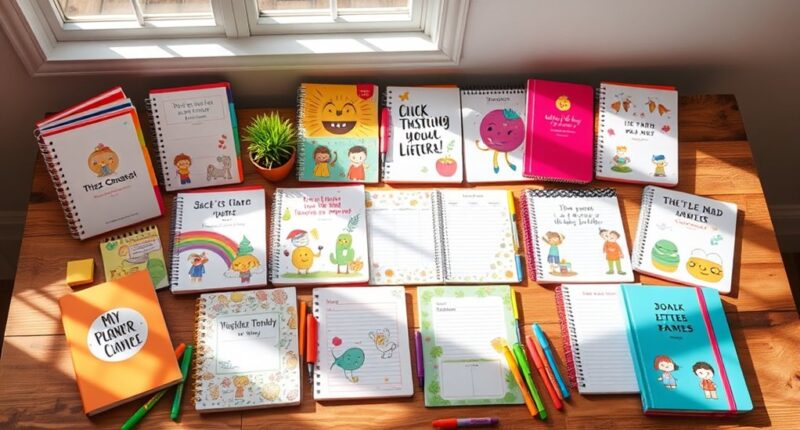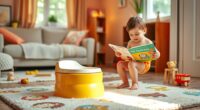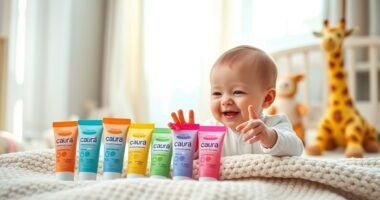I’ve found some fantastic planners to help your kids stay organized and focused! The Global Datebooks Dated Elementary Student Planner is great for younger kids, while the Homicozy Kids Unicorn Diary offers creative fun. For middle schoolers, try the bloom daily planners Day Planner. Each option provides unique features, ensuring there’s something for every child. Keep exploring to discover the complete list and find the perfect planner that suits your child’s needs!
Key Takeaways
- Choose planners tailored for specific age groups, like the Global Datebooks for elementary or middle/high school students, to enhance organization skills.
- Look for planners with interactive features, such as the LIKARTO® Weekly Planner, to engage children in managing their schedules independently.
- Select creative options like the Homicozy Kids Unicorn Diary, which encourage personal expression while helping children develop writing and planning habits.
- Ensure planners include educational resources, such as goal trackers in the Erin Condren Kids Planner, to promote self-discipline and personal growth.
- Prioritize durability and usability by choosing planners with high-quality materials and user-friendly layouts for daily handling by children.
Global Datebooks Dated Elementary Student Planner for Academic Year 2024-2025
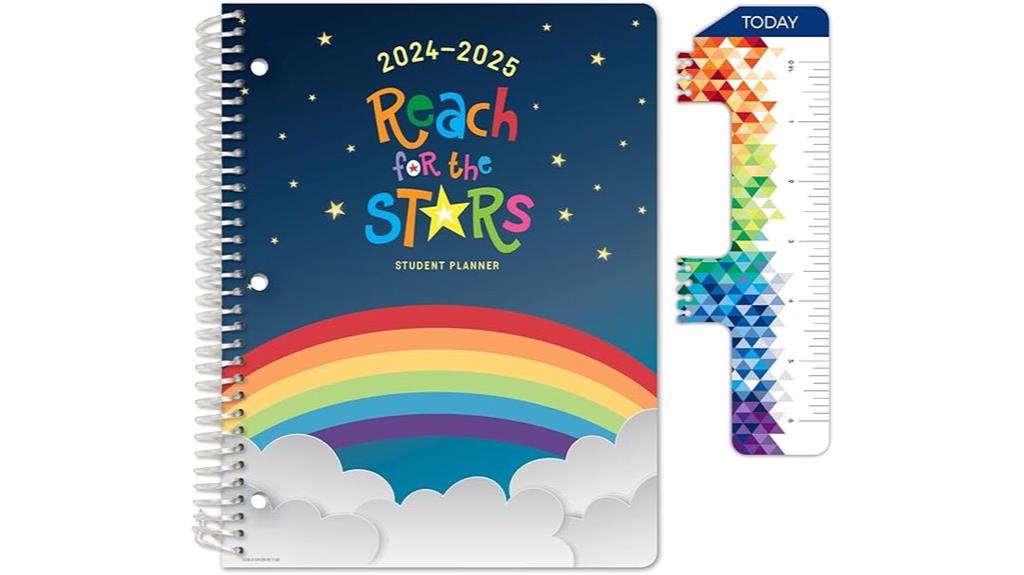
If you’re looking for a planner tailored specifically for elementary students, the Global Datebooks Dated Elementary Student Planner for the 2024-2025 academic year is a fantastic choice. Measuring 8.5 x 11 inches, this planner runs from August 2024 to June 2025. It features a dated weekly format for assignments and monthly calendars for important dates, making organization easy. The colorful cover and spiral binding are appealing to kids. Plus, it includes a bonus bookmark/ruler and planning stickers. With positive feedback highlighting its ease of use and vibrant graphics, this planner definitely helps children stay on track with their schoolwork.
Best For: The Global Datebooks Dated Elementary Student Planner is best for elementary school students looking to stay organized and manage their assignments effectively throughout the academic year.
Pros:
- Colorful cover and spiral binding appeal to children, making it fun to use.
- Dated weekly format and monthly calendars simplify tracking assignments and important dates.
- Includes bonus features like a bookmark/ruler and planning stickers for added creativity.
Cons:
- Some limitations for homeschooling families due to alignment with traditional school dates.
- May not provide enough space for detailed notes or extensive planning.
- The planner is designed specifically for elementary students, which may not be suitable for older students.
Homicozy Kids Unicorn Diary with Lock and Key
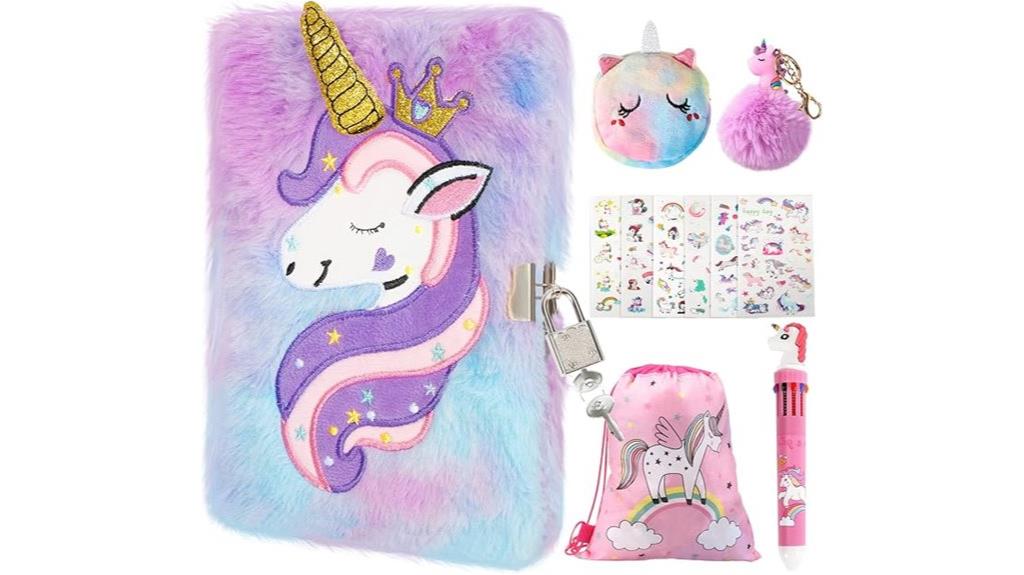
The Homicozy Kids Unicorn Diary with Lock and Key is a delightful choice for young girls aged 6 and up who adore unicorns and cherish their creativity. With a soft fuzzy cover and colorful tie-dye design, it’s perfect for expressing thoughts and dreams. Inside, you’ll find 160 lined pages, ideal for writing or drawing. The lock keeps secrets safe, and it’s easy to use independently. Plus, the included stickers, multicolor pen, keychain, coin purse, and storage bag make it a fantastic gift. Overall, it’s a fun, creative way for kids to stay organized while enjoying their imaginative side!
Best For: Young girls aged 6 and up who love unicorns and enjoy writing or drawing.
Pros:
- Fun and colorful design with a soft fuzzy cover that appeals to children.
- Includes a variety of accessories, such as stickers and a multicolor pen, enhancing creative play.
- Lock mechanism provides a sense of privacy and security for personal thoughts.
Cons:
- Some customers have reported concerns about the durability of the lock.
- Mixed experiences regarding the functionality of the lock mechanism.
- May not appeal to children who prefer different themes or designs over unicorns.
bloom daily planners 2025 Calendar Year Day Planner
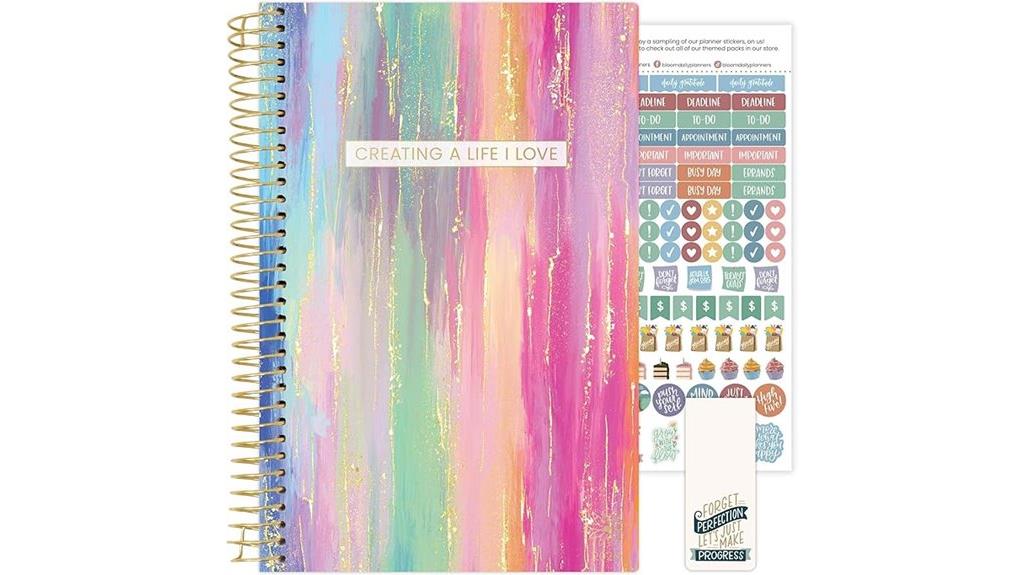
Looking for a planner that truly inspires kids to stay organized? The bloom daily planners 2025 Calendar Year Day Planner is a fantastic choice! Measuring 5.5” x 8.25”, it features stylish designs and includes a free sticker sheet to make planning fun. With spacious weekly views and monthly tabs, kids can easily track assignments and goals. Plus, it’s packed with life coaching worksheets to help them develop valuable skills. I love the commitment to community, too—every purchase supports empowering women. With a stellar rating of 4.8 stars, it’s definitely worth considering for an organized year ahead!
Best For: The bloom daily planners 2025 Calendar Year Day Planner is best for students and individuals seeking an organized and motivating way to manage their schedules and goals.
Pros:
- Stylish designs with a variety of cover options to suit personal tastes.
- Includes life coaching worksheets that promote personal development and goal-setting.
- Compact size and lightweight design make it easy to carry around.
Cons:
- Some users may find it overpriced compared to other planners on the market.
- Limited to a 2025 calendar year, which may not meet long-term planning needs.
- Not all users may find the life coaching worksheets relevant to their planning style.
Homework Planner for Kids (Undated Weekly and Daily Pages)

Designed with elementary, middle, and high school students in mind, the Homework Planner for Kids is a fantastic tool for anyone needing extra guidance, especially those with ADHD. Its undated weekly and daily pages allow for flexible planning, making it easy to track assignments across subjects. I love the waterproof covers that protect it from spills, plus the inner pocket keeps important papers organized. Users appreciate its straightforward design, though some find the small line spacing a bit challenging. Overall, this planner promotes independence and responsibility, helping kids manage their tasks effectively while developing essential organizational skills.
Best For: The Homework Planner for Kids is best for elementary, middle, and high school students, especially those with ADHD or needing extra guidance in managing their tasks.
Pros:
- Straightforward design that makes tracking assignments easy.
- Waterproof and wipe-clean hardcovers protect against spills and dirt.
- Encourages independence and responsibility in managing tasks.
Cons:
- Some users find the small line spacing challenging for writing.
- Mixed reviews on effectiveness, with some children rarely using it independently.
- Desire for more engaging features to promote consistent use.
LIKARTO® Weekly Planner for Children with Magnetic Board and 194 Magnets
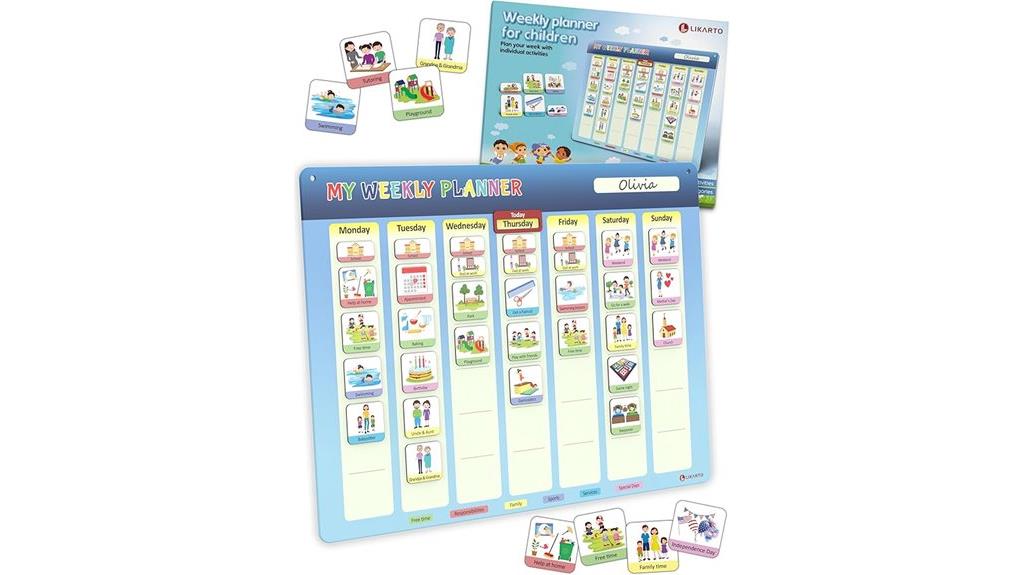
For young learners enthusiastic to develop their organizational skills, the LIKARTO® Weekly Planner with its magnetic board is an excellent choice. With 194 magnets, including 161 activity magnets, it makes planning engaging and fun. The fully writable and wipeable surface allows kids to customize their schedules easily. I love how it fosters independence by helping children grasp their weekly routines. Plus, its sturdy construction guarantees durability, which is perfect for active kids. Rated 4.6 stars, it’s well-loved by parents for promoting responsibility. Overall, this planner is a fantastic tool for any child looking to stay organized and focused!
Best For: The LIKARTO® Weekly Planner is best for young learners eager to develop their organizational skills and understand their weekly routines.
Pros:
- Encourages independence and responsibility in children.
- Engaging design with a variety of magnets that make planning fun.
- Durable construction suitable for active use by kids.
Cons:
- Limited diversity in represented figures among the magnets.
- Some users suggested needing additional magnets for various activities.
- May require regular cleaning to maintain the writable surface.
Undated Weekly Planner with Habit Tracker (A5, Pink)
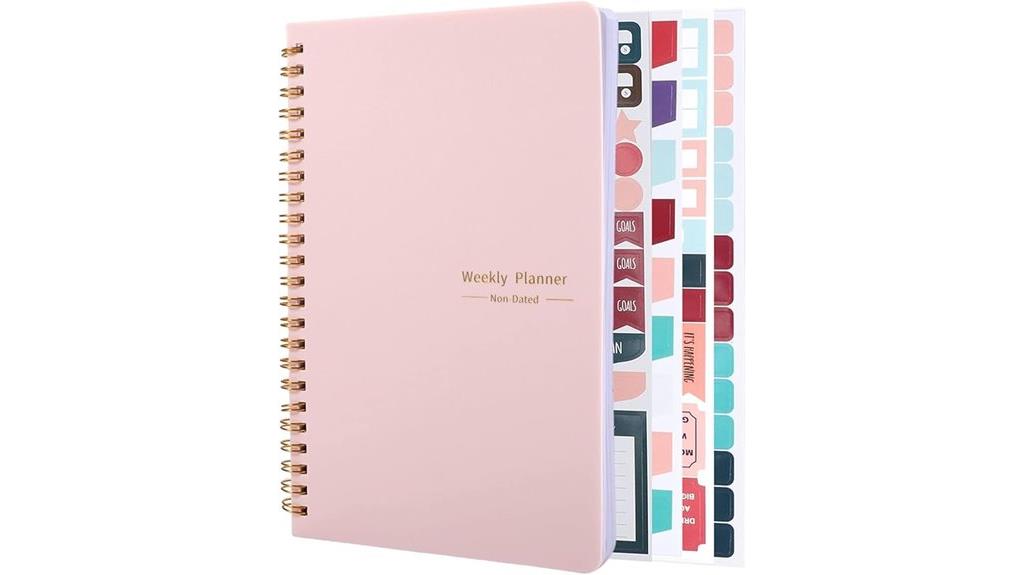
The Undated Weekly Planner with Habit Tracker (A5, Pink) is perfect for young girls enthusiastic to organize their busy lives. This stylish planner features a spiral binding for easy page turning and a compact A5 size that fits perfectly in a backpack. The undated format means you can start any time, reducing waste. I love how the habit tracker helps maintain good habits, while the weekly layout keeps goals and to-do lists front and center. Plus, it comes with fun stickers to mark important tasks. With a 4.5-star rating, it’s definitely a favorite among users!
Best For: This planner is best for young girls and women looking to effectively organize their tasks and goals in a stylish and portable format.
Pros:
- The undated format allows users to start planning at any time, reducing wasted pages.
- The compact A5 size makes it easy to carry around in a backpack or purse.
- Includes a habit tracker and fun stickers to enhance the planning experience and help maintain good habits.
Cons:
- Some users suggest adding an undated monthly spread for better long-term planning.
- Feedback indicates confusion with the weekend date fields; a clearer layout could improve usability.
- The design may be more appealing to a younger audience, potentially limiting broader appeal.
Erin Condren Kids Planner & Activity Book (7 x 9 2nd Edition)
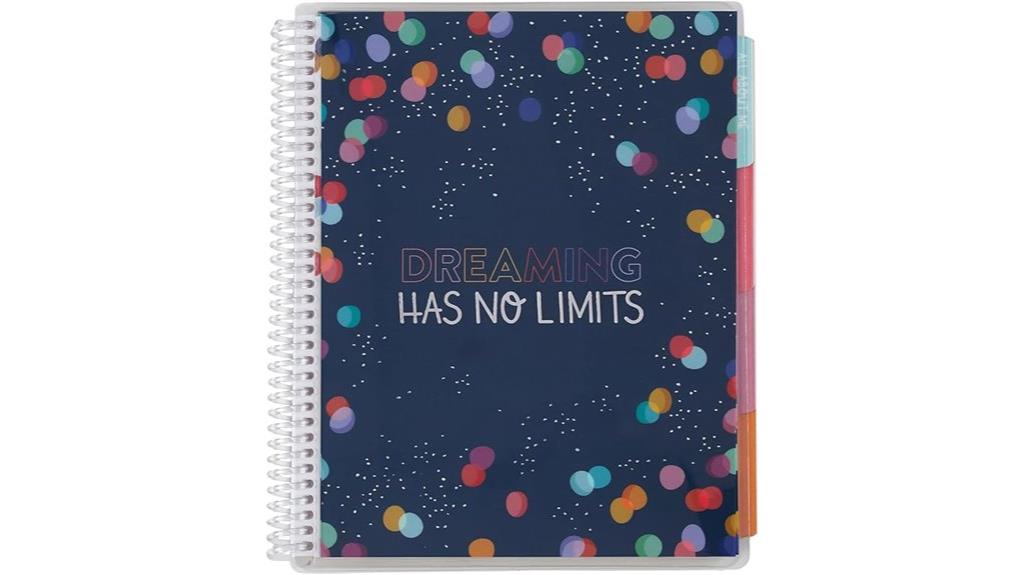
Kids aged 5 to 9 will thrive with the Erin Condren Kids Planner & Activity Book (7 x 9 2nd Edition), which encourages essential skills like time management and organization. This undated planner features fun activity sheets, goal trackers, and reading logs that engage kids creatively. I love the gender-neutral design, making it perfect for any child. The “All About Me” section helps build confidence, while the monthly routine pages teach responsibility. With a rating of 4.8 stars from over 300 reviews, it’s clear parents appreciate its quality and effectiveness. It’s a fantastic tool for helping kids manage their activities and set goals!
Best For: Kids aged 5 to 9 who are looking to develop time management and organizational skills in a fun and engaging way.
Pros:
- Encourages essential skills like self-discipline and responsibility through interactive features.
- Gender-neutral design makes it suitable for all children.
- Highly rated by parents for its quality and effectiveness in helping kids set goals and manage activities.
Cons:
- Additional interchangeable covers sold separately may increase overall cost.
- Undated format may require parents to assist younger children in tracking their planning.
- Some users may find the layout less suitable for older kids approaching 10 years.
Global Datebooks Student Planner for Academic Year 2024-2025

Looking for an effective way to stay organized during the academic year? The Global Datebooks Student Planner for 2024-2025 is a fantastic choice! Measuring 7 x 9 inches, it runs from August 2024 to June 2025, making it perfect for school schedules. I love its dated weekly format for assignments and the MATRIX layout for days and months. Plus, the colorful cover and spiral binding make it visually appealing. With resource pages for study skills and positive customer feedback, it scores 4.7 out of 5 stars. And hey, there’s a 30-day return policy if it doesn’t meet your needs!
Best For: Students in middle school or high school looking for a structured and visually appealing way to manage their academic schedules.
Pros:
- The dated weekly format allows for effective organization of assignments and tasks.
- Colorful cover and spiral binding make it visually appealing and easy to use.
- Includes educational resource pages that support study skills in various subjects.
Cons:
- The size may not be sufficient for students who prefer larger writing spaces.
- Limited to a school year, requiring a new planner each academic year.
- May not have enough space for detailed notes or long assignments.
Big Life Journal – Daily Journal for Kids
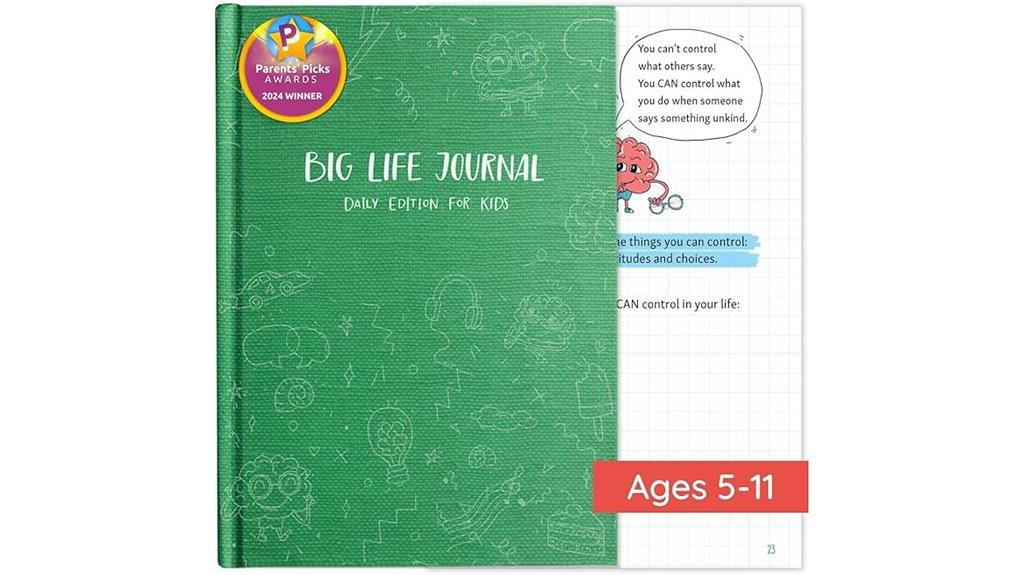
For children ages 6 to 11, the Big Life Journal – Daily Journal for Kids is a fantastic tool that promotes a growth mindset while encouraging emotional health. This interactive journal features daily prompts that guide kids in expressing their feelings, helping them build resilience and confidence. With 112 pages of high-quality paper and a durable hardcover, it’s designed for daily use. Plus, it includes colorful stickers to add a fun touch! Rated 4.6 out of 5 stars, parents rave about its effectiveness for emotional regulation. I believe this journal can truly make a positive difference in your child’s life.
Best For: Children ages 6 to 11 who are looking to develop a growth mindset and improve their emotional health.
Pros:
- Encourages self-reflection and emotional regulation through daily prompts.
- Durable hardcover and high-quality paper make it suitable for daily use.
- Includes colorful stickers that add an engaging and positive element to journaling.
Cons:
- Limited age range may not cater to older children or teens.
- Some children may require guidance to fully utilize the journal’s prompts.
- The size of the journal may not be ideal for all writing preferences.
Tiny Expressions Kids Coloring Calendar 2025
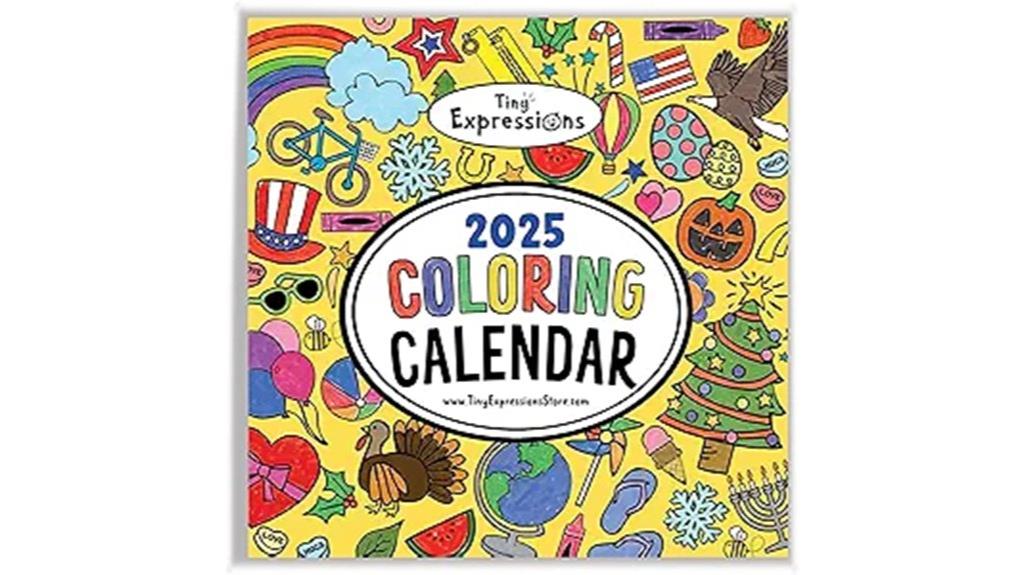
With its engaging Color Your Own designs and educational focus, the Tiny Expressions Kids Coloring Calendar 2025 stands out as an excellent choice for children enthusiastic to learn about time management. This 12-month wall calendar not only features seasonal illustrations but also promotes creativity as kids color in each month. The functional layout, which opens to 24 inches, makes it easy to view scheduled activities, chores, and important school due dates. Designed by parents for effective learning, it’s ideal for home or school. With a 4.8-star rating, it’s a popular gift that fosters organization and family traditions.
Best For: Children who are eager to learn about time management and enjoy creative activities.
Pros:
- Engaging Color Your Own designs that encourage creativity and artistic expression.
- Functional layout that clearly displays scheduled activities, chores, and school due dates.
- High customer rating (4.8 out of 5 stars) indicates positive experiences and satisfaction among users.
Cons:
- Limited to a single year (2025), which may not suit long-term planning needs.
- May require supervision for younger children to ensure safe coloring practices.
- Some parents might prefer a more structured calendar format without coloring elements.
Daily Planner Undated Notebook with Hourly Schedule & To-Do List
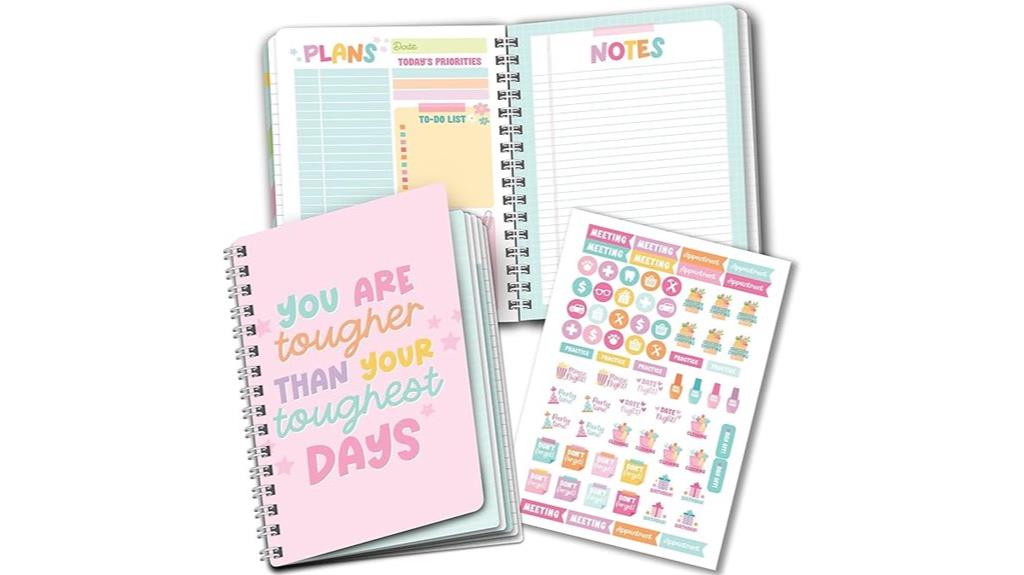
The Daily Planner Undated Notebook is perfect for kids and busy parents alike, as it combines organization with a fun design. Measuring 5.8 x 8.3 inches, its Doodle Pink Stars cover is both cute and practical. I love that it’s undated, allowing us to use it without wasting pages. With a full page for daily schedules, a to-do list, and even a gratitude section, it keeps everything organized. Plus, the included sticker sheet adds a fun touch! With a stellar rating of 4.9 out of 5, it’s clear this planner helps us achieve our goals efficiently.
Best For: The Daily Planner Undated Notebook is best for busy parents and kids looking for an organized yet fun way to manage their daily schedules and tasks.
Pros:
- The undated format provides flexibility and prevents wasted pages.
- It features a full page layout for daily scheduling, enhancing organization.
- The included sticker sheet adds a fun and creative element to planning.
Cons:
- The planner’s size may be too small for those who prefer larger formats.
- The design may not appeal to everyone, as it targets a more playful aesthetic.
- Limited to daily planning; lacks weekly or monthly overview pages.
100 Daily Checklist for Kids Planner Notepad
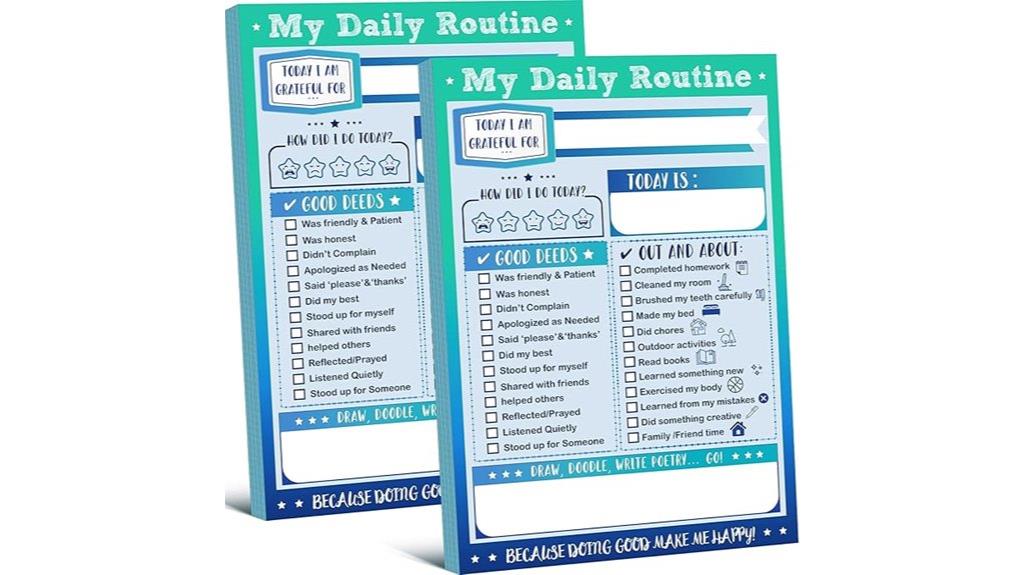
Kids who thrive on structure will find the Daily Checklist for Kids Planner Notepad invaluable. This planner includes two notepads with 50 pages each, perfectly sized for easy storage and portability. It encourages kids to develop good habits and fosters independence while teaching essential organizational skills. Whether it’s tracking daily tasks, moods, or schedules, this versatile tool can adapt to various activities like meal planning or study tracking. With its vibrant design and clear printing, children stay engaged and motivated to complete their checklists. Plus, it’s highly rated, making it a worthwhile addition to your child’s routine.
Best For: Kids who thrive on structure and need a tool to develop good habits and organizational skills.
Pros:
- Encourages independence and responsibility in children.
- Versatile usage for various activities like meal planning and studying.
- Engaging design with vibrant colors that motivates kids to complete tasks.
Cons:
- Some users have expressed concerns about the tear-off design.
- A few customers reported a noticeable chemical smell.
- Limited to a specific format, which may not suit all children’s preferences.
ibii™ Children’s Action Planner and Journal
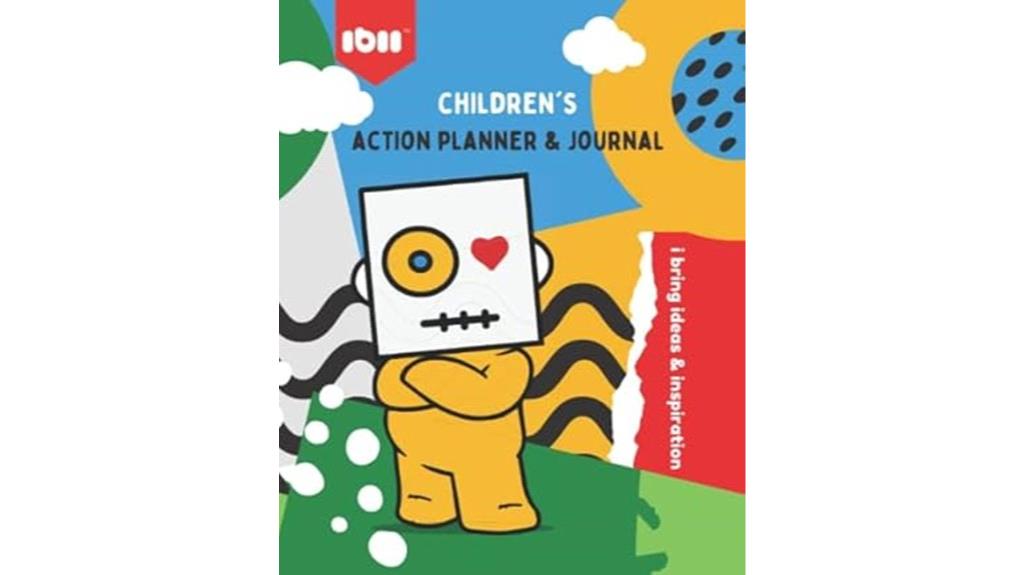
For parents seeking an engaging way to foster their child’s emotional intelligence, the ibii™ Children’s Action Planner and Journal stands out as an ideal choice. I love how it promotes positivity through reflective questions that encourage kids to think about how they help others and express empathy. Each morning, it prompts them to set goals, cultivating a habit of self-awareness and achievement. Plus, the creative activities allow for fun self-expression, like drawing or designing t-shirts. With thoughtful guidance for parents, this journal not only inspires creativity but also nurtures gratitude and positive thinking—making it a must-have for any child.
Best For: Parents looking to enhance their child’s emotional intelligence and self-awareness through engaging and creative activities.
Pros:
- Encourages empathy and positive thinking through reflective questions and goal setting.
- Offers creative activities that allow for fun self-expression and artistic exploration.
- Provides guidance for parents, making it easier for children to engage meaningfully with the journal’s content.
Cons:
- Some children may require additional motivation to consistently use the journal.
- The structure may not appeal to all children, particularly those who prefer unstructured play.
- Limited focus on traditional academic skills, which may be a drawback for some parents.
STMT DIY Bullet Journaling Kit for Girls Ages 8
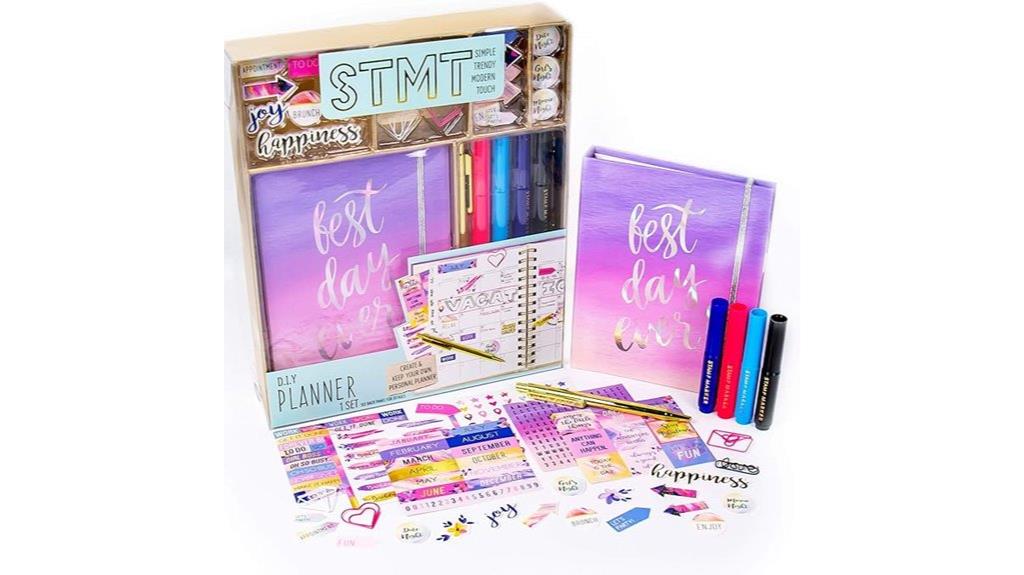
Designed specifically for girls ages 8 and up, the STMT DIY Bullet Journaling Kit offers a creative outlet that encourages personal expression through planning. This kit includes a planner, a notebook, and over 50 stationery essentials, like stickers and a gold pen, perfect for customizing their space. With 12 monthly pages and flexible viewing options—daily, weekly, and monthly—your child can easily organize tasks and deadlines. Rated 4.6 stars by happy customers, this kit not only minimizes stress but also fosters creativity. It’s an ideal companion for school, camps, or just daily life, helping kids develop important planning skills.
Best For: Girls ages 8 and up who enjoy creativity and organization through personal planning.
Pros:
- Encourages creativity and personal expression with customizable stationery.
- Helps develop important planning and organizational skills.
- Flexible viewing options (daily, weekly, monthly) cater to different planning styles.
Cons:
- Some users have noted the need for additional glue for certain decorations.
- The kit does not include pre-dated pages, which may be inconvenient.
- Limited to a specific age group, potentially less appealing for older teens.
Factors to Consider When Choosing Children’s Planners
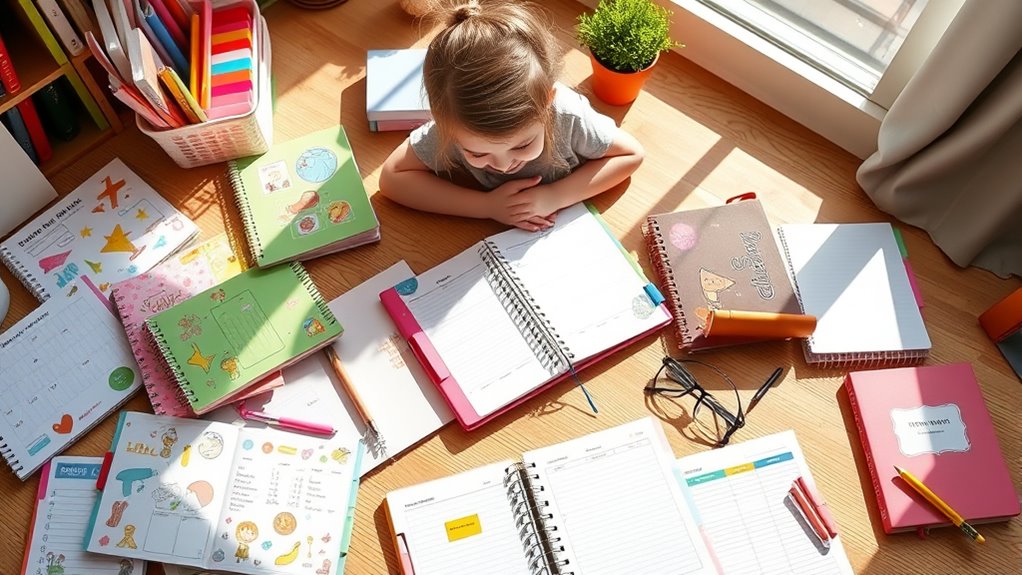
When I’m choosing a planner for my child, I consider several key factors to guarantee it’s the right fit. Age appropriateness, design, and usability are just a few aspects that can make a big difference. I also think about the educational value and how portable the planner is for their daily activities.
Age Appropriateness
Choosing age-appropriate planners is essential for ensuring that children can engage with the content effectively. For younger kids, ages 5 to 7, I find that planners featuring simple layouts, bright visuals, and interactive elements keep their interest piqued. They’re more likely to use a planner that feels fun! For older children, ages 8 to 12, planners can include more complex features like goal-setting sections and habit trackers to foster responsibility and independence. It’s also helpful to reflect on your child’s interests—planners themed around their favorite characters can boost motivation. Finally, I always check that the language and prompts are age-appropriate, as this helps children comprehend and engage meaningfully with the planning process.
Design and Aesthetics
While selecting a planner for your child, the design and aesthetics play an essential role in capturing their interest and encouraging regular use. I’ve found that vibrant colors and engaging graphics are vital; they simply make the planner more appealing. Look for planners featuring a variety of cover designs and customizable elements, as this personal touch invites kids to connect with their planner. Playful themes, like animals or fantasy characters, can resonate with children and motivate them to use it consistently. Also, guarantee the size and layout are user-friendly, with clear sections and enough space for their handwriting and drawings. Finally, interactive elements like stickers or activity prompts can enhance visual appeal and spark their creativity, making planning fun!
Usability and Functionality
To guarantee your child’s planner is effective, usability and functionality should be top priorities. I always look for clear, structured layouts that feature daily and weekly sections. This way, kids can easily track their assignments and tasks without feeling overwhelmed. Functional aspects, like waterproof covers and durable binding, are essential for withstanding daily use. I also love planners that include engaging elements, like colorful graphics and stickers, as they encourage kids to use their planners creatively and regularly. Additionally, user-friendly designs, such as easy-to-turn pages and clear prompts for goal setting, foster independence. These features collectively help children take ownership of their planning, making the experience not only useful but also enjoyable.
Educational Value
When selecting a planner for your child, the educational value it offers can make a significant difference in their development. Look for planners that include goal-setting prompts and daily reflections; these features promote self-awareness and personal growth. I love how many planners incorporate interactive elements like stickers and activity sheets, which make learning about organization fun and engaging. Including resource pages covering subjects like math and study skills can also provide helpful tools for academic success. If your child has ADHD or needs extra support, planners with structured layouts can aid in managing tasks and fostering independence. Positive feedback from parents shows these planners can effectively teach responsibility and time management, both essential for their overall growth.
Size and Portability
Choosing the right size and portability for your child’s planner can greatly influence their willingness to use it regularly. I’ve noticed that planners typically range from A5 (about 5.8 x 8.3 inches) to larger formats like 8.5 x 11 inches, so you can pick one that suits your child’s needs. A lightweight design, around 10-12 ounces, makes it easy for them to carry in their backpacks. Look for planners with spiral bindings, as they allow for easy page turning and flat opening, which kids find user-friendly. Compact sizes, like 6.3 x 9 inches, are perfect for little hands. Plus, many planners are undated, giving your child the flexibility to start whenever they want without being tied to a calendar year.
Customization Options
Customization options in children’s planners can considerably boost their enthusiasm for planning and organization. When kids can personalize their planners with stickers, drawings, and creative designs, they feel a sense of ownership that makes planning more enjoyable. Many planners offer unmarked pages or undated formats, allowing children to engage whenever they’re ready, giving them flexibility. Some include fun elements like themed stickers and stationery sets that inspire creativity and self-expression. Plus, customizable layouts—daily, weekly, or monthly—let them choose what works best for their learning style. Providing blank magnets or activity options can further enhance parent-child collaboration, tailoring routines that truly reflect their unique needs and goals.
Durability and Quality
Durability and quality are essential factors to evaluate in children’s planners because they directly impact how well the planner will hold up to daily adventures. I always look for options with waterproof or wipe-clean covers to protect against spills and dirt, ensuring they last longer. High-quality binding, like spiral or hardcover, prevents tearing and keeps pages intact. It’s also crucial to choose planners made from thick, smooth paper that resists bleeding and smearing, enhancing the writing experience. A sturdy design with reinforced corners can help withstand the wear and tear from kids’ daily use. Finally, I make sure the materials are safe and certified, ensuring they meet health and safety standards suitable for children.
Frequently Asked Questions
What Age Group Is Suitable for Children’s Planners?
I believe children’s planners are suitable for kids as young as six or seven. At this age, they start understanding how to manage simple tasks and schedules. I’ve found that introducing a planner early helps them develop organizational skills. It’s also a fun way for them to express their creativity. As they grow, they can handle more complex planners, making it a great tool throughout their school years.
How Can Planners Benefit Children’s Time Management Skills?
Planners promote powerful time management! I’ve noticed that using a planner helps kids prioritize tasks, breaking down big projects into manageable parts. It teaches them to set deadlines and stick to schedules. I’ve seen my child become more responsible and confident in handling their time. With regular use, they learn to balance homework, hobbies, and relaxation, fostering essential skills that will benefit them for years to come. It’s truly transformative!
Are There Planners Specifically Designed for Special Needs Children?
Absolutely, there are planners specifically designed for special needs children. I’ve found that these planners often include visual aids, simplified layouts, and customizable sections that cater to various learning styles. They help kids manage their time and tasks in a way that feels comfortable for them. If you’re looking for one, I recommend checking out options that focus on sensory-friendly designs and offer prompts to encourage engagement and independence.
Do Planners Come in Digital Formats for Tech-Savvy Kids?
Planners today are as advanced as rocket science! Yes, there are definitely digital formats for tech-savvy kids. I’ve found that many apps and online tools offer customizable features, making planning fun and engaging. These digital planners often include reminders, calendars, and even gamified elements that keep kids motivated. I love how these tools not only help with organization but also encourage my kids to embrace technology in a positive way.
How Can Parents Encourage Kids to Use Their Planners Consistently?
Encouraging kids to use their planners consistently can be a fun journey. I’ve found that setting a routine helps; I remind my kids to check their planners each morning and evening. Making it a family activity, like planning weekend outings, keeps them engaged. I also celebrate their achievements, no matter how small, which motivates them. Plus, letting them personalize their planners makes it feel special, and they’re more likely to use it regularly.
Conclusion
In a world where kids are basically mini CEOs managing their own schedules, finding the right planner is key to keeping them organized and focused. Whether they’re juggling homework, activities, or social events, the right planner can make a world of difference. So, explore these fantastic options and help your little ones harness their inner productivity geniuses. After all, even Benjamin Franklin would agree that a good plan is the secret to success!
